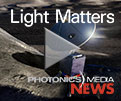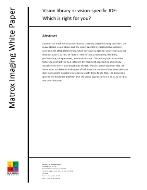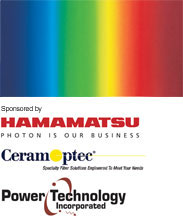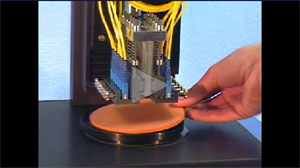 
 |
Graphene Photosensor Detects Broadband Light
A broad-spectrum photodetector developed using pure graphene is a thousand times more light-sensitive than current sensors and able to detect wavelengths from the visible to the mid-infrared, making it suitable for all camera types. The new image sensor was invented by assistant professor Wang Qijie of the School of Electrical & Electronic Engineering at Nanyang Technological University (NTU) in Singapore. “We expect our innovation will have great impact not only on the consumer imaging industry, but also in satellite imaging and communication industries, as well as the mid-infrared applications,” he said. |
|
|
|

State of Industry Subject of Photonics North Keynote
The market for photonics in North America and the rest of the world, as well as projections for the rest of 2013 and 2014, is the subject of a keynote address by the Optical Society’s (OSA) Tom Hausken at Photonics North 2013, being held this week in Ottawa. |
|
|
|

Printing Innovations Improve Organic Electronics
A printing technique that focuses on the physics of the process rather than the chemical makeup of the semiconductor provides a tenfold improvement in organic electronics, findings that could yield flexible electronic displays, tiny sensors and lightweight, low-cost solar cells. |
|
|
|




AIA: North American Machine Vision Sales Climb 10% in Q1
Machine vision sales in North America for the first quarter of 2013 grew 10 percent year-over-year, largely driven by a resurgence of application-specific machine vision (ASMV) systems, according to the AIA, the industry’s trade group. |
|
|
|

Light-Controlled Gel Could Benefit Soft Robots
Inspired by the way plants grow toward light sources, bioengineers at the University of California, Berkeley, created a hydrogel that flexes in response to near-IR laser light. The achievement could be a step toward adding softness and flexibility to robotics. |
|
|
|

Same-Energy Electrons Pulsed from Laser Accelerator
Electron pulses — all with nearly the same tunable energy — have been produced from a laser accelerator at the Laboratory for Attosecond Physics. The accomplishment makes electrons, which travel at a velocity close to the speed of light, easier to control as a tool for ultrafast physics experiments. |
|
|
|

 |
On this edition of the industry's only weekly newscast: A light-controlled get could help soften robots, the first privately owned telescope readies for space, and a graphene photosensor could eliminate the need for photo flashes. Hosted by Photonics Media's Melinda Rose and Ashley Rice. |
|
|

Light-Sensitive Material Promising for 3-D Shaping
A light-sensitive resin that responds to the process of “carbonizing,” or charring, could provide scientists with a new material that can be molded into complex, highly conductive 3-D structures with features just a few microns across, such as 3-D microelectrodes that interface with the brain. |
|
|
|

European Groups Appoint Young Ambassador for Photonics Education
The University of Bonn's Jana Huisman, 18, will use her passion for physics in her new appointment as Young Ambassador for Photonics Education. The position was created by Photonics21 and the European Commission and presented at the Photonics21 annual meeting this spring. |
|
|
|

Light Coupled in Fiber Oscillates Longitudinally
Lightwaves, which typically oscillate perpendicular to their propagation direction, have been seen oscillating longitudinally when coupled into glass fibers, suggesting that light and matter couple much more strongly than previously thought, say physicists at the Vienna University of Technology. |
|
|
|

 |
Vision Library or Vision-Specific IDE: Which is right for you?
Matrox Imaging, Division of Matrox Electronic Systems Ltd.
Commercial machine vision software is currently classified along two lines: the conventional vision library and the vision-specific integrated development environment (IDE). Determining which software is right for your vision project depends upon a variety of factors: ease-of-use, productivity, flexibility, performance, completeness, and maintenance. This white paper uses these factors to contrast the two software development approaches and clearly establish the merits and drawbacks of each.
DOWNLOAD WHITE PAPER >> |


WEBINAR

 |
Join Us for a Free Webinar
2013 Webinar Series - Expert Briefings
Raman Spectroscopy for Research and Industry
Monday, June 24, 2013 – 1 p.m. EST/10 a.m. PST
 Photonics Media will host David J. Brady, the Michael J. Fitzpatrick Endowed Professor of Photonics at Duke University, where he leads the Duke Imaging and Spectroscopy Program. He will discuss “Computational and Compressive Raman Spectroscopy,” reviewing coded aperture, multiwavelength and diffuse illumination Raman system design for ultraviolet, visible and SWIR systems. Brady also will discuss compressive sampling for infrared Raman spectroscopy. Photonics Media will host David J. Brady, the Michael J. Fitzpatrick Endowed Professor of Photonics at Duke University, where he leads the Duke Imaging and Spectroscopy Program. He will discuss “Computational and Compressive Raman Spectroscopy,” reviewing coded aperture, multiwavelength and diffuse illumination Raman system design for ultraviolet, visible and SWIR systems. Brady also will discuss compressive sampling for infrared Raman spectroscopy.
 Photonics Media also will host Dr. Prasant Potuluri, CEO and co-founder of Centice. He will present a “Review of Key Applications of Raman Spectroscopy” to include identification of narcotics and explosives, counterfeit drug detection, quality control, raw material identification and manufacturing process improvements. Dr. Potuluri also will discuss some limitations of Raman spectroscopy and opportunities for improvement. Photonics Media also will host Dr. Prasant Potuluri, CEO and co-founder of Centice. He will present a “Review of Key Applications of Raman Spectroscopy” to include identification of narcotics and explosives, counterfeit drug detection, quality control, raw material identification and manufacturing process improvements. Dr. Potuluri also will discuss some limitations of Raman spectroscopy and opportunities for improvement.
|
|
|

CLEO 2013 - June 9 - 14, 2013 · San Jose, CA
Visit Photonics Media at Booth 2027 |

 |
CLEO, the Conference on Lasers and Electro-Optics, is the premier international forum for scientific and technical optics, uniting the fields of lasers and electro-optics by bringing together all aspects of laser technology, from basic research to industry applications. CLEO 2013 will feature its technical program under three core conferences; CLEO: QELS-Fundamental Science, CLEO: Science & Innovations, and CLEO: Applications & Technology.
The CLEO: Market Focus program focuses on the latest trends in the photonic marketplace, providing a forum to discuss new products and emerging technologies and markets while also providing network opportunities. Presentations for this year include Industrial Laser Outlook and Opportunities, Photonics Entrepreneurs, Medical and Aesthetic Lasers – The Future of Light-tissue Interactions, and Optics & Innovation for Energy & the Environment. Free exhibit floor programs include the Market Focus program, Technology Transfer Showcase, OSA’s Executive Speaker Series and the CLEO: Expo Technology Playground, where top industry players will demonstrate their latest products and services in an exclusive on-floor event that allows attendees to participate in live, interactive presentations.
MORE INFO >> |
|
|
 |


Follow Photonics Media on Facebook and Twitter
|
   |
|

FEATURED VIDEO

Krell Technologies
Automated Fiber Optic Polishing System
Scepter is PC controlled for consistent and Telcordia compliant polishing of optical connectors and bare fiber. Technicians are prompted through each process step via the user friendly interface. Various polishing procedures are easily programmed for all connector types and surface finishes. In-line video inspection streamlines production and minimizes component handling.
|
|
|

sponsor
 |

sponsor
 |


sponsor
 |

sponsor
.jpg) |

sponsor
 |


|